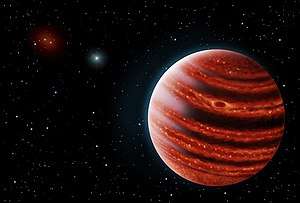51 Eridani b
| Exoplanet | List of exoplanets | |
|---|---|---|
 | ||
| Parent star | ||
| Star | 51 Eridani | |
| Constellation | Eridanus | |
| Right ascension | (α) | 04h 37m 36.13234s |
| Declination | (δ) | −02° 28′ 24.7749″ |
| Distance | 96 ± 1 ly (29.4 ± 0.3 pc) | |
| Observed separation Observation epoch 2014 [1] | ||
| Angular separation | (ρ) | 449 ± 7[1] mas |
| Position angle | (θ) | 171.1 ± 0.9[1]° |
| Projected separation | (d) | 13.2 ± 0.2 [1] AU |
| Physical characteristics | ||
| Mass | (m) | 2 [1] MJ |
| Radius | (r) | 1 [1] RJ |
| Temperature | (T) | 700 K[1] |
| Discovery information | ||
| Discovery date | Dec 2014 | |
| Discoverer(s) | Macintosh et al. | |
| Discovery method | Imaged | |
| Discovery status | Published[1] | |
| Database references | ||
| Extrasolar Planets Encyclopaedia | Eridanus&p2=b data | |
| SIMBAD | data | |
| Exoplanet Archive | Eridanus+b data | |
| Open Exoplanet Catalogue | Eridanus+b data | |
51 Eridani b is a "Jupiter-like" planet that orbits the young star 51 Eridani, in the constellation Eridanus.[2] It is 96 light years away from the solar system, and it is approximately 20 million years old.[3]
General information
51 Eridani b was announced in August 2015, but was discovered in December 2014 using the Gemini Planet Imager, an international project led by the Kavli Institute for Particle Astrophysics and Cosmology. 51 Eridani b is the first exoplanet discovered by the Gemini Planet Imager.[4] The Gemini Planet Imager was specifically created to discern and evaluate dim, newer planets orbiting bright stars through “direct imaging.”[5] Direct imaging allows astronomers to use adaptive optics to sharpen the resolution of the image of a target star, then obstruct its starlight.[5] Any residual incoming light is then scrutinized, and the brightest spots suggest a possible planet.[5]
Scientists estimate the mass to be twice that of Jupiter,[6] and it has the second strongest methane signature of any exoplanet, after GJ504b.[7] This methane signature, along with the low luminosity of the object, should produce additional clues as to how 51 Eridani b was formed.[4] The average temperature is 700 K, which is substantially hotter than the 130 K average temperature of Jupiter, the planet in the Solar System of closest size.[8] Astromers also detected the presence of water in the planet's spectrum.[9] It orbits the star 51 Eridani in the constellation Eridanus. Atmospheric modeling favors a low surface gravity partly cloudy atmosphere.[6] Prior to the discovery of 51 Eridani b, each of the directly-imaged worlds previously discovered have been gas giants many times the mass of Jupiter.[6]
References
- 1 2 3 4 5 6 7 8 Discovery and spectroscopy of the young Jovian planet 51 Eri b with the Gemini Planet Imager, B. Macintosh, and the GPIES team, Science Published Online August 13, 2015 doi:10.1126/science.aac5891.
- ↑ Choi, Charles (August 13, 2015). "Found! 'Young Jupiter,' the Smallest Exoplanet Directly Seen by Telescope". Retrieved August 15, 2015.
- ↑ Hadhazy, Adam (August 13, 2015). "'Young Jupiter' 51 Eridani b: Why Directly Imaging an Exoplanet Is Big". space.com. Retrieved August 15, 2015.
- 1 2 University, Stanford (13 August 2015). "Astronomers discover 'young Jupiter' exoplanet".
- 1 2 3 Culler, Jessica (14 August 2015). "NASA Scientists Help Understand Newly Discovered Planet".
- 1 2 3 Billings, Lee. "Astronomers Glimpse a Young Jupiter, 51 Eridani b".
- ↑ "Astronomers Discover Young Planet That Looks Like Jupiter 100 Light Years Away".
- ↑ "Exoplanet 51 Eridani b: A Red-Hot Young Jupiter Around Distant Star (Infographic)".
- ↑ "Young 'alien Jupiter' discovered". 14 August 2015 – via www.bbc.co.uk.